There are various ways to say "tattoo" in Japanese: tatwuu タトゥー, irezumi 刺青 (or 入れ墨), and horimono 彫り物. This post will talk about the differences between them.
Anime: Gokushufudou 極主夫道 (Episode 1)
タトゥー
The word tatwuu タトゥー, a katakanization of the English word "tattoo," is the western fashion kind of tattoo.
Anime: Black Lagoon, ブラック・ラグーン (Episode 2)
- Context: Revy has a "tribal," toraibaru トライバル, tattoo.
To refer to a tattoo on a certain body part, just use the term for the body part before the word tattoo, normally with no の particle between them, turning the body part into a no-adjective. Some examples:
Anime: Yū☆Yū☆Hakusho 幽☆遊☆白書 (Episode 9)
- Context: the "swastika," manji 万字, is a religious symbol seen in Buddhism.
- atama no tatwuu
頭のタトゥー
Tattoo of the head.
Head tattoo. - hitai no tatwuu
額のタトゥー
Tattoo of the forehead .
Forehead head. - kao no tatwuu
顔のタトゥー
Tattoo of the face.
Face tattoo.
Anime: Taboo Tattoo, タブー・タトゥー (Episode 5)
- Context: not an akanbee あかんべえ.
- shita no tatwuu
舌のタトゥー
Tattoo of the tongue.
Tongue tattoo.
Anime: One Piece (Episode 570)
- Context: Nami and her money eyes.
- kata no tatwuu
肩のタトゥー
Tattoo of the shoulder.
Shoulder tattoo. - ude no tatwuu
腕のタトゥー
Tattoo of the arm.
Arm tattoo.
Anime: Code:Realize ~Sousei no Himegimi~ ~創世の姫君~ (Episode 1)
- Context: a magical tattoo.
- mune no tatwuu
胸のタトゥー
Tattoo of the chest.
Chest tattoo.
Anime: Yuri!!! on Ice, ユーリ!!! on ICE (Episode 8, Stitch)
- Context: a tramp stamp of his own initials.
- koshi no tattoo
腰のタトゥー
Tattoo of the hip.
Hip tattoo.- koshi - the area from the lower back, to the sides at the hip, to the front around the hip bones.
- shiri no tattoo
尻のタトゥー
Tattoo of the butt.
Butt tattoo.- Typically on the buttocks, rather than above them.
Game: Bombergirl
Image source: https://wikiwiki.jp/9988/アクア, accessed 2021-05-08.
- Context: a heart-shaped crotch tattoo is an anime meme.
- kafukubu no tatwuu
下腹部のタトゥー
Tattoo of the lower abdomen.
Lower abdomen tattoo. - inmon
淫紋
"Lewd crest." (anime slang.)
Known as a "womb tattoo" in the English anime fandom.
入れ墨
The word irezumi 入れ墨, literally "inserting ink," is a native way of saying the word "tattoo" in Japanese.
It comes from the words ireru 入れる, "to put in," and sumi 墨, "ink." The s turns into z because of rendaku. This is not to be confused with the semordnilap sumiire 墨入れ, which means "ink bottle" or "inking [something]."
The verb "to tattoo" is in fact the verb "to put in:"
- ireru
入れる
To put in [the ink].- To ink in. To tattoo.
- tatwuu wo ireru
タトゥーを入れる
To put in a tattoo. To ink in a tattoo. To tattoo a tattoo.- ude ni tatwuu wo ireru
腕にタトゥーを入れる
To insert a tattoo in [your] arm.
To tattoo your arm.
- ude ni tatwuu wo ireru
- tatwuu wo kesu
タトゥーを消す
To erase a tattoo. To remove a tattoo.- ude kara tatwuu wo kesu
腕からタトウーを消す
To erase a tattoo from [your] arm.
- ude kara tatwuu wo kesu
Historically, during the Edo period (1603–1868), irezumi 入れ墨, also spelled irezumi 入墨, without okurigana, referred to the tattoos tattooed to criminals' faces or arms, which marked that they had been found guilty of their crimes.
Right: Jin 仁
Anime: Samurai Champloo, サムライチャンプルー (Episode 1)
- Context: the two rings tattooed on Mugen's arms imply he's a criminal.
- bokkei
墨刑
"Ink punishment." The practice of tattooing a criminal to mark them for life, that is, using tattoos as a form of criminal record.
Further in the past, the term gei 黥 used to refer to a tattoo on someone's face, while bunshin 文身 referred to a tattoo on their body.
刺青
The word irezumi 刺青 is a common ateji for irezumi 入れ墨 that started being used in the Meiji period.
It comes from the short story Shisei 刺青, by novelist Tanizaki Jun'ichirō 谷崎潤一郎, published in 1910. The English title is "The Tattooer," so you can guess what were the contents of the story.
Today, shiseishi 刺青師 means a "tattooer," by the way. Just like renkinjutsushi 錬金術師 means an "alchemist."
In Japan, tattoos used to be associated with gangs and criminal activity. Besides the historical origin of the word irezumi, many yakuza movies had characters in gangs that featured tattoos, causing the audience associate one thing to the other.
Given this, to some people a tatwuu タトゥー refers to a fashionable western tattoo, the small kind you can show to anyone without prejudice, while irezumi 刺青 refers to the larger, more traditional ones.
A lot of people don't make this distinction, however, and use both terms interchangeably.
- nanda yo kore... irezumi?
なんだよコレ・・・刺青?
What is this... a tattoo? - e'? honmono ka!?
えっ?本物か!?
Eh? It's real!? - un
うん
Yeah.
彫り物
The term horimono 彫り物 is another way to say "tattoo" in Japanese.
Literally, it means "carving/engraving thing," in the same sense tabemono 食べ物, "food," is literally "eating thing."
The term was in use at the same time as irezumi 入れ墨, but, unlike irezumi, it wasn't branded on criminals.
The horimono was usually tattooed on fishermen, firemen, and so on. People who worked jobs were they wouldn't be wearing many clothes, so their skin, and the tattoo, would be visible most of the time.
Unlike tatwuu タトゥ and irezumi 刺青, the term horimono 彫り物 generally doesn't refer to small tattoos. It refers to large ones, which covers a person's whole back, or arms, or chest, or full-body tattoos, done in a traditional Japanese style.
Anime: Inuyashiki いぬやしき (Episode 4)
Since horimono only means something that's engraved, it can also refer to engravings done on other things, like the engraving on the blade of a katana.
和彫り
The term wa-hori 和彫り, "Japanese engraving," is a modern synonym for the horimono 彫り物 tattoo.
See Also
- gyaru ギャル
A type of girl that might have a tattoo. - "Piercing" in Japanese
References
- 日本でタトゥーはタブーなのか 「不快」の声に当事者は - asahi.com, accessed 2019-04-04.
- 刺青・入れ墨・タトゥーの違いとは|彫りもの・紋々の定義と歴史 - do-tt.jp, accessed 2019-09-13.
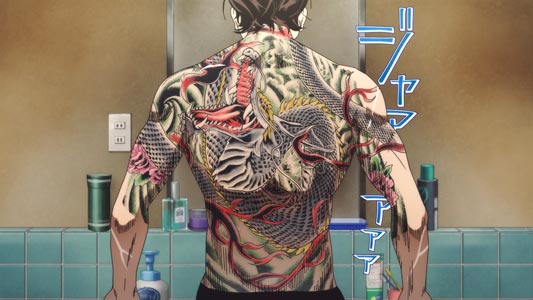
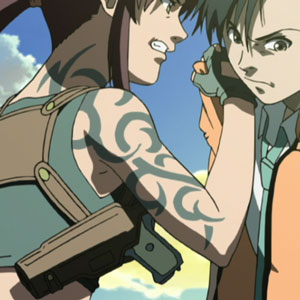
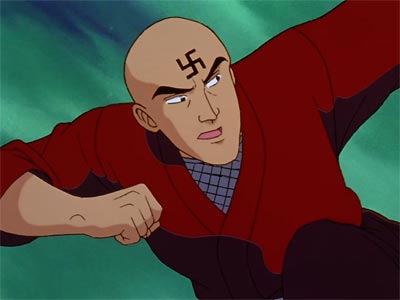
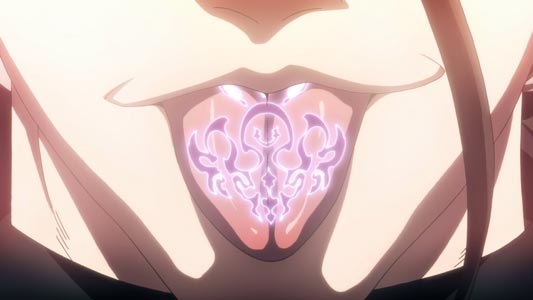

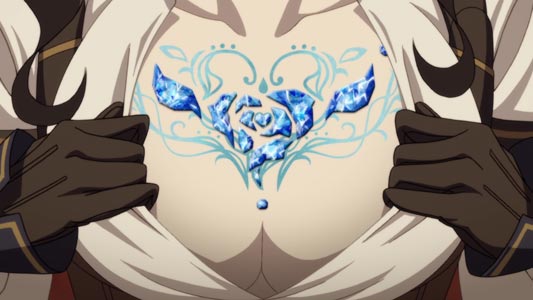
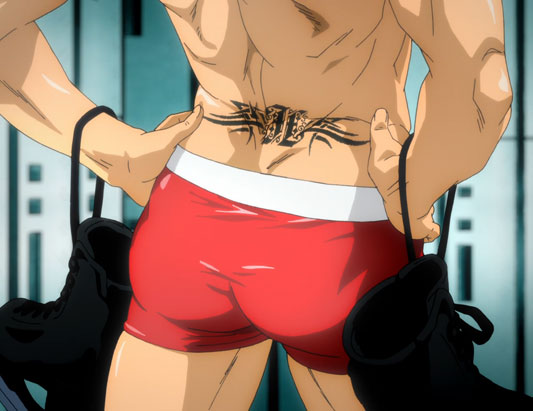
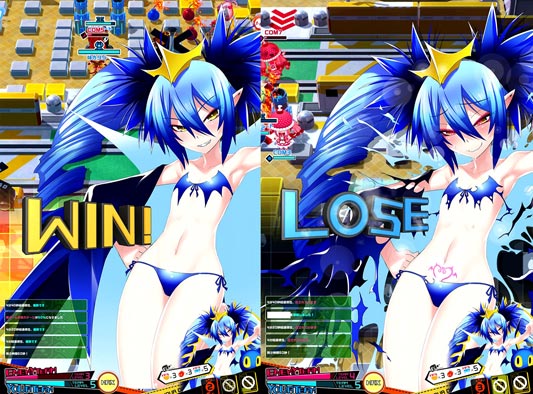
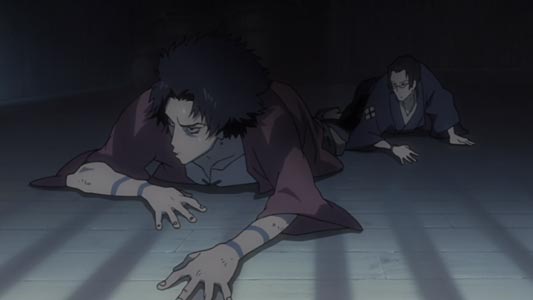
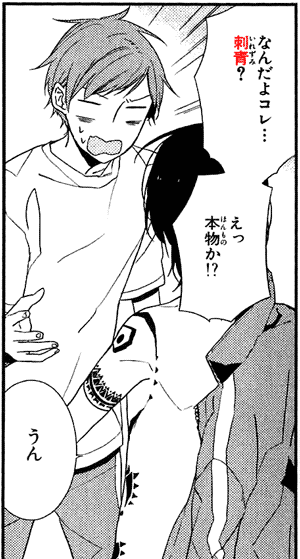
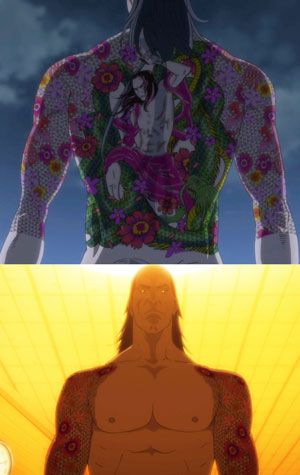
No comments: